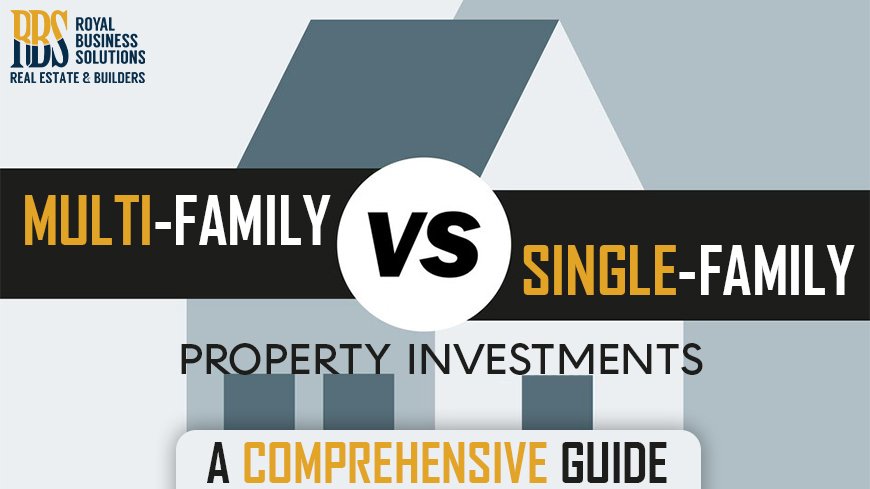- October 30, 2023
- Posted by: Muhammad Shehzad
- Category: Blogs

Introduction
Real estate has long been a favored investment choice for individuals looking to build wealth and generate passive income. Among the various real estate investment options, multi-family vs single-family properties are two popular choices. Both offer unique advantages and disadvantages, making the decision between the two a crucial one for potential investors.
In this blog, we’ll talk about investing in single-family vs multi-family homes, the benefits and drawbacks of each type of investment property, and what you can expect from your investment.
Multi-Family Property
Multi-family properties are buildings with multiple occupants, such as apartments or flats. Moreover, they are self-contained communities. The main attraction here is the possibility of earning rental revenue from multiple units under one roof at the same time.
Benefits include:
- Greater cash flow each month
- Economies of magnitude
- Functional effectiveness
- Improved financing options
Single Family Property
Single-family homes are ideal for investors who are looking to actively manage their property. Because they are easier to finance and there is less competition when purchasing, they are also excellent for novices. Single-family homes generally offer lower returns than multifamily properties, which is their primary drawback.
Benefits include:
- Lower Entry Barriers
- Reduced tenancy rate
- Higher liquidity
Read: How The Property Market Ended 2023, And What’s On The Cards For 2024
Key Differences Between Multi-Family and Single-Family Investments
Financing and Costs
Single-family homes appear cheaper to start with, but multi-family units offer higher ROI due to multiple income streams. Banks may favor single-family homes for lower risk, but multi-family properties justify their higher upfront costs with greater long-term returns.
Management and Maintenance
The investor has an obvious tenant relationship with a single-family property. However, multi-family property management presents complex dynamics, ranging from community connections to more constant maintenance demands, due to the various tenant personalities and needs.
Flexibility in Investment
Single-family houses enable investors to geographically diversify with less capital because they require minor investments. While concentrating investment in one place, multi-family properties provide a single, but more reliable, source of income.
Market Demand and Stability
There is a constant market for single-family homes, but there is an essential high need for multi-family housing near urban centers or educational institutions. Even the demand for multi-family property rentals can increase during economic downturns.
Which Investment is best for you?
Determining the ideal investment choice depends on individual preferences and uniqueness, making the multi-family vs. single-family debate without a one-size-fits-all solution.
Key Factors to Consider:
To find the best fit, explore popular real estate investment strategies or take these factors into account:
Investment Goals
Your investment goals play a significant role. Are you seeking cash flow, capital gains over the long term, or both? Single-family properties are often better for appreciation, while multi-family properties excel in generating cash flow.
Risk Tolerance
Assess your risk tolerance. Single-family properties may involve lower risks, but they may not offer as high a return on investment as multi-family properties, which often come with a bit more risk due to the larger investment.
Market Conditions
Local market conditions heavily influence your decision. Study the supply and demand for both single-family and multi-family properties in your chosen area.
Management Style
Consider your management preferences. Are you willing to be more hands-on with single-family properties or do you prefer a more hands-off approach with professional management in multi-family properties?
Financing and Budget
Evaluate your financing options and budget constraints. Single-family properties may require less capital upfront, but multi-family properties can offer better long-term returns.
Exit Strategy
Have an exit strategy in mind. Do you plan to hold the property for the long term, or is a shorter investment horizon your goal? Your choice can impact whether single-family vs multi-family properties make more sense.
Also Read: Future Of Property Investment Analysed – And How Capital Smart City Fits In
Conclusion
In the multi-family vs. single-family property investment debate, there’s no best answer. Both types of properties have their unique advantages and disadvantages. Whether you choose single-family or multi-family properties, be sure to thoroughly analyze potential properties, consider financing options, and understand the local market dynamics. And remember, while there is no definitive answer to which is better, both single-family and multi-family properties can be lucrative investments when approached with a well-thought-out strategy.
Furthermore, Capital Smart City offers luxurious living with high-priority residential options.
